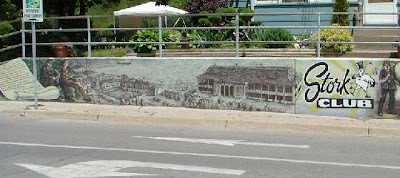Blog 16… December, 2012
Remembrance Day passed a while ago and I was struck by several pieces in newspapers
referring to the art of war, also by Pat Barker describing her latest novel Toby’s Room, about an art instructor at the Slade School in
London who aids in reconstructing the faces of injured soldiers during and after
WW1. More about that in a future blog,
but it set me to thinking more about remembering and memorialising events and
people through art – there was a bit about it in my blog on tattoos, here’s more.
In 1999, ten years after 14 young female engineering
students at L’Ecole Polytechnique were gunned down on December 6th in
what’s become known as the Montreal Massacre, my friend BA and I were invited
to be part of an event at Massey Hall called Fourteen Remembered
Genevieve Bergeron ….. Helene
Colgan….. Nathalie Croteau….. Barbara Daigneault
Anne- Marie Edward…..
Maud Havernick….. Barbara Maria Klucznick…..
Maryse Laganiere.... Maryse Leclair… Anne- Marie Lemay
Maryse Laganiere.... Maryse Leclair… Anne- Marie Lemay
Sonia
Pelletier….. Michelle Richard….. Annie St Arnaud….. Annie Turcotte
Created by dancer and choreographer Peggy Baker and her
husband, the late composer Ahmed Hassan, it was a performance of sorrow and joy,
incorporating an original composition for each of the women. There were solemn processions
of women and children (that’s where BA and I came in) individual dance performances and rituals of mourning and
honouring the dead from different cultures. A number of moving texts about the lives of
courageous women past and present
inspired us in the face of the sadness of remembering. The theme
throughout was to hold the women’s names in our hearts as they were chanted
over and over in a mesmerizing way as background to the music, the dance and
the spoken words, imprinting the names in our minds in the process of
remembering.
Genevieve Bergeron ….. Helene Colgan….. Nathalie Croteau….. Barbara Daigneault
Anne- Marie Edward….. Maud Havernick….. Barbara Maria Klucznick…..
Maryse Laganiere.... Maryse Leclair… Anne- Marie Lemay
Maryse Laganiere.... Maryse Leclair… Anne- Marie Lemay
Sonia Pelletier….. Michelle Richard….. Annie St Arnaud….. Annie Turcotte
The event came and went too quickly, but I have a CD of the
sound of Fourteen Remembered and as I listen to it each year on December 6th
I can recreate some sense of what the day looked and felt like. This is in memory of the 14 women killed in
Montreal 23 years ago and also of Ahmed Hassan, who composed and performed much
of the music and whose voice brought us the names of the women.





































